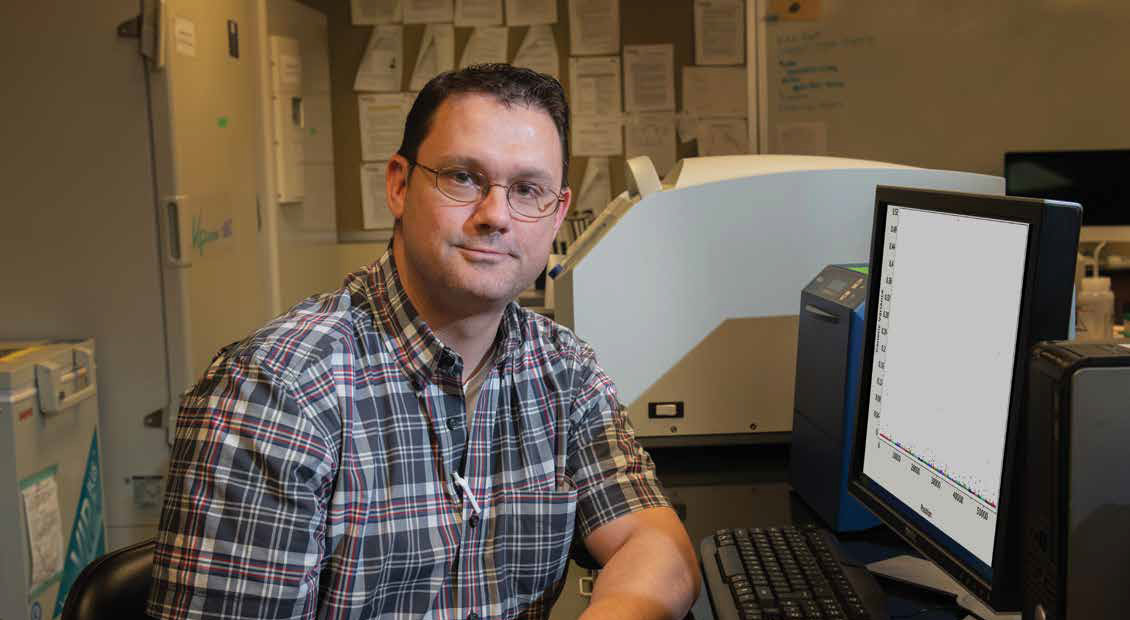
Technology and Genetic Information in the Cattle Industry
How Beef Producers Share Data

There are roughly 32 million beef cattle in the United States and understanding the genetic composition of cattle can help producers make better decisions for the entire herd, according to Matt Spangler, professor and beef genetics specialist in the Department of Animal Science at the University of Nebraska–Lincoln. Spangler works in the area of beef genetics and his research offers new technology options to further the understanding of genetic information.
“If the beef industry wishes to remain competitive, we need to adopt technology at a much faster rate,” Spangler said, “We need to make good use of the information we have.”
Spangler said technology allows both genetic and genomic information to be shared more easily. Genetics is the study of heredity. More specifically, genetics focuses on how one trait is passed from one generation to the next. Spangler said studying the gene, the most basic unit of heredity, explains differences in the phenotype (set of observable characteristics) between animals and we know that cumulatively, genes have a substantial impact on understanding the animal.
Genomics looks at the entire genome (billions of base pairs) across the animal. Spangler said the amount of genomic data available has dramatically increased in the last decade. This genomic information allows producers to make decisions more accurately and efficiently than ever before.
The addition of genomic (DNA marker) information into genetic selection tools produces more accurate predictions of genetic merit, allowing producers to make more rapid genetic change to their herd to increase net profit whilst meeting consumer demands. One way this is achieved is by using genomic information to better quantify the relationships between animals. Further, producers using genetic information and sharing data throughout the beef chain helps beef continue to be a driving competitor of other protein choices.
However, Spangler said technological advances are needed to make data sharing a reality in beef genetics. His research focuses on developing and evaluating methods to enable data sharing underpinned by genomics with the hopes of better making use of data collected throughout the industry.
“If the industry could get even a fraction of that data to be shared through genetic evaluations, genetic selection tools used to decrease susceptibility to disease could be developed,” Spangler said.
Power in Partnerships
Spangler said partnerships may also be a path to share data among interested parties.
“Partnerships throughout the entire beef chain will also change the way data is shared and gathered,” Spangler said.
The state of Nebraska has taken strides to create such partnerships to increase the sharing of information to improve genetic selection tools. Specially, Nebraska’s resources of beef gives the state the advantage to be a leader in changing the way the beef industry uses technology.
As of February 2019, Nebraska ranks first in beef production, beef product exports and all cattle on feed, while ranking second in total number of cattle and calves, Spangler said. These resources in the state are vital for being a leader in beef genetic research.
Spangler said the synergies that exist between the Nebraska agricultural community and the university are critical to not only meet the demands of a growing population, but also to discover new tools, new methods and new strategies, as well as enhance agricultural production in the future.
He stressed the importance of partnerships between the industry and academia to drive public opinion. New, novel and perhaps unconventional partnerships will allow stronger market placement of products as well as better marketing of the use of technology in the industry, he said.
Future of Beef Genetics
Spangler offered suggestions on the direction of future research in beef genetics.
First, Spangler said the genetic and genomic information will continue to become even more accurate for use in making precise selection decisions (who should be retained for breeding) and will also become valuable in informing how animals should be managed. The process of predicting observable characteristics through genetic information will be more prevelant in research in future years.
Second, research in beef genetics will focus on “making use of the plethora of data that exists in this industry outside of seedstock herds,” Spangler said. For example, the pedigree (record of descent of an animal) of animals in feedlots remains unknown, and therefore, there is limited information shared about these animals. Spangler said technology, like genomics, can help connect these animals to others that do have recorded pedigree. He plans to provide more information in this area in future years.
Finally, technology development such as genetic selection tools will continue to evolve to place even more focus on the healthfulness of meat products and eating quality, providing even greater consumer satisfaction.
“Genetic selection tools will not only be important in providing information on the traits we have now, but also for traits that we don’t have now, such as the health of the animal,” Spangler said. These tools are just one example of new technology advancements planned for beef genetics in the future.
The beef industry is not only important to Nebraska. Beef reaches across the nation and around the world. And therefore, improving the use of technology in beef genetics also stretches across the entire country.
“The beef industry is more than just Nebraska. It’s regional, national, worldwide,” Spangler said. “Through my research, I hope to help the global beef industry and do so from its epicenter, Nebraska.”